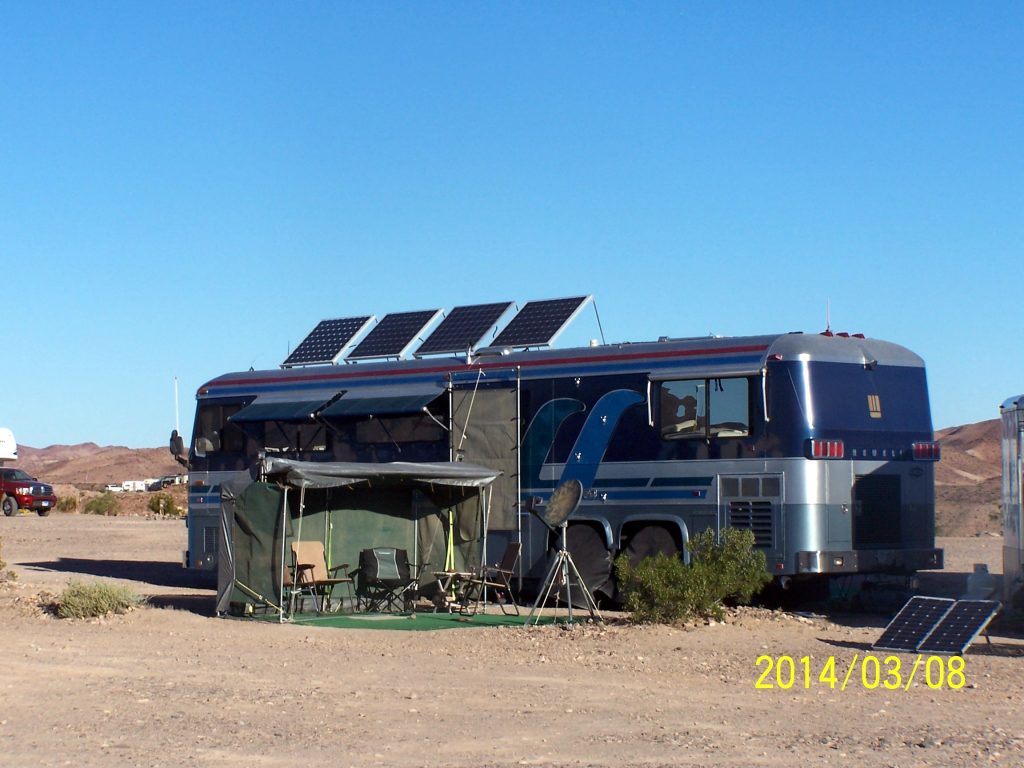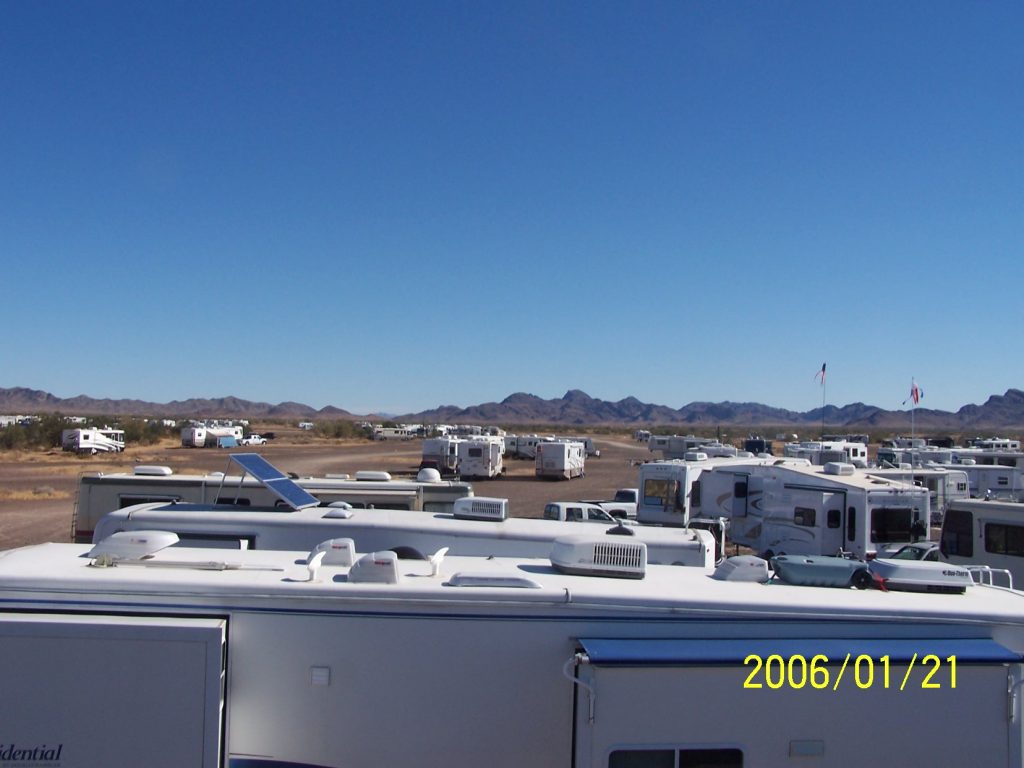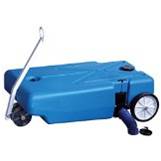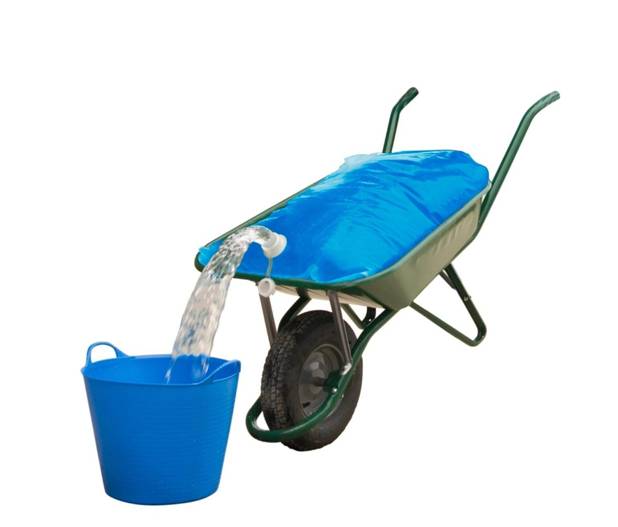Kathy and I love everything about boondocking. We haven’t, however, done much of it. We know many folks who spend much of their time RVing by camping off the grid in some very beautiful places. Over the years, I have learned quite a bit about this unique style of camping.
I don’t want to get hung up in the definition of “boondocking.” Some folks call it dry camping when you spend a night without hook-ups, like in a Wal-Mart parking lot. Whatever you call it, we are talking about spending nights in an RV without external water, sewer, or power.
Why Boondocking?
People boondock for many reasons. For some, it means inexpensive or in many cases free camping. This is where overnight stays at Wal-Mart or other large store parking lots comes in. When you are moving from one location to another, it’s easier to spend a night in a Wal-Mart (“Wallydocking”) than to book a campground. Another term we read recently is Mooch Docking, or staying at a friend’s or relative’s place for a while, often hooked up to power.
Many boondockers don’t want to be “cooped up” in a campground with its many activities and kids and barking dogs. They crave solitude. Others like the challenge of living “off the grid” for extended periods of time. Many love to be living in beautiful, natural locations where the only sounds are from nature.
Unfortunately, in today’s economy, many people camp “off the grid” by necessity as they cannot afford better housing. This brings up the term “Stealth Camping.” This is where folks move around from place to place, often arriving late at night to avoid the local authorities. We are not advocates of Stealth Camping.
No matter the reason, it is all about conservation. You must conserve water, as your tanks only hold so much. You must conserve power, or electricity, as batteries only hold just so much charge. You must conserve fuel if you use a generator. You should use good land conservation practices. Leave the spot you are camped in a little cleaner than when you found it.


Water Conservation
This is an area where bigger really does mean better. The larger your rig, the larger your holding tanks will be(usually). Many small Class C motorhomes have only 20 gallons of fresh water and about 10 gallons of space in the gray and black water tanks. Larger rigs also will have more propane storage ability as well as the ability to have larger battery banks.
In a rig properly set up for boondocking, water holding capacity usually determines how long you can stay in one spot. Obviously, you should arrive at your campsite with empty holding tanks and a full water tank. Now I’m not advocating that you not stay clean, but you will save a lot of water if you only shower every 2 or 3 days. When you do shower, learn how to take a “Navy” shower, so called because Navy ships have to use most of the fresh water to keep the ship running, so water is at a premium. To do this, either start with cold water until the warm reaches the shower head, or collect that cold water for use later for washing dishes or toilet flushing. Get wet and turn off the water. Then soap up and shampoo your hair. Then rinse off as quickly as you can and turn off the water. Many shower heads have shut-off valves, but most will still allow a trickle of water to flow and be wasted. There are aftermarket shut-off valves that will close completely. There, that wasn’t so bad, was it?
While you’re out shopping for a shower shut-off, you might also want another shut-off valve to put in the water supply line to the toilet(s). This way you can use that water you collected before your shower to flush with. I know several boondocking couples that can live off grid for more than 2 weeks on just a 100 gallon fresh tank and 50 gallon waste tanks. I can’t. This is where learning to wash your hair in a cup of water comes in handy. No joke, we know several women that can do this.
Use paper plates and bowels wherever you can as well as plastic tableware to lighten the dish washing load. Wash your dishes in a plastic washtub and use the leftover dish water for toilet flushing. This is where you will really discover togetherness when you and your spouse share a flush. Saves a lot of flushing water if you can learn to go at the same time.
There are ways to extend your stay beyond your tank’s capacity. If there is a dump station fairly close, you can use a portable tank, known affectionately as a “blue boy” and fill it with up to 40 gallons of either black or grey water. You hook it up to your tow vehicle of towed car and take it to the dump station. You will be making multiple trips.
There are large capacity plastic bladders that can hold fresh water for transfer into your fresh water tank. With water weighing over 8 pounds per gallon, you need to plan very carefully where to put one when it’s full. The 20 gallon bladder in the picture will weigh 160 pounds when full. These are just suggestions I know. Talk with enough long term boondockers and you’ll find many more solutions to extend your water tank capacity.
Power Conservation
Your RV’s 12 volt battery bank or “house battery bank”, is your RV’s lifeblood when you are camping off grid. It supplies control power to all your propane appliances as well as power for all the lighting in your RV. These batteries should be the “deep cycle” type that can be discharged to a much lower level than the starting battery and can go through many of these charge/discharge cycles. The vast majority of RV house batteries are the flooded cell type with caps for each cell. This is where you put in distilled water to top off the sulfuric acid based electrolyte that makes the battery work. These can be either 12 volt or 2 six volt batteries in a series configuration. The much more popular six volt batteries will provide more cycles of charge and usually produce more “Amp hours of power output than the 12 volt variety. This measurement tells you how much current can be withdrawn from the battery in a 20 hour period. More is always better with this measurement. Sometimes another pair of 6 volt batteries will be added in a parallel configuration to provide double the output current. There are other types of batteries covered in the chapter on the 12 volt electrical system. I have seen rigs wit 8 6 volt batteries in the house battery bank.
The trick is keeping all those batteries charged. Most RV have a converter that converts 120 volts AC power to 12 volts as well as a battery charging circuit, but they only work when park power is available. Boondockers charge their batteries in several ways.
An on-board generator will provide the power for the converter to work to charge the batteries. Most converters are inexpensive units that do more harm than good as they can boil the electrolyte in your batteries thus killing them over time. The better solution is a 3 stage charger that reduces the bulk charge that does the damage. The next 2 stages bring the battery to full charge safely. There are 3 problems using your generator. They use fuel from your tank, so you only have that much. The second is the noise they can make. Third is that generators emit carbon monoxide that must be closely monitored.
A preferred method depending on local weather conditions is solar power from photo-voltaic cells mounted on the top of the RV. We’ll cover that in a later section. Another similar method is wind power.
Inverters
An inverter is an electronic device that converts the 12 volt DC power from the batteries to 120 volts AC for your AC powered appliances like TV’s, coffee makers, etc. Unfortunately, inverters cannot generate enough AC power to run even one air conditioner. You must decide how much AC power you will need on a daily basis and size your inverter accordingly. They can be as much as 3000 watts, but require a large battery bank to keep them running.
Solar Power
Solar power is hugely popular with dedicated boondockers. After your initial investment, it provides “free” power to charge your battery bank from the sun. Obviously, you must be in an area that has a lot of daily sunlight to take full advantage. The heart of a solar system is the solar panels that each contain many individual photo voltaic cells that convert sunlight to DC voltage. The more panels you have, the more amp hours you can put back into your batteries. Between solar panel and batteries is a solar charge controller that converts the voltage from the panels to 12 volts for the batteries. You may ot for a panel mount for the panels that can be tilted to take advantage of the winter sun which is at a lower angle in the sky.
The initial expense can run into the $3000 dollar range for a 400 watt solar system, so do your homework and calculate just how much solar, if any, you need. If you only boondock occasionally, you may decide it isn’t worth the investment.
Wind Power
There are wind generators available for RV use that can generate as much as 400 watts if the wind is steady and strong enough. The generator must be raised up above the RV on a mast of some sort. As far as I can tell, wind power just isn’t popular enough to get good data.
Fuel Conservation
As mentioned earlier, generators run off the RV’s fuel tank until the level gets to about 1/4 where the fuel line tap is located for the generator. That gives you enough fuel to get out to get more fuel. There are some generators that use propane for fuel. That means drawing down your on-board propane tank.
That propane is used to power the burner of your water heater as well as the heating coils in an RV absorption refrigerator. It is also used to power the burner in your forced air furnace(s). It is also the fuel for your range and oven if equipped. It is possible to retrofit your rig with an RV Extend-a-Stay device that allows an outboard tank to provide propane for your rig. With 2 tanks you can go to town and refill the empty one.
As you meet other folks who are boondockers and express your interest, they may invite you along to share their “secret” boondocking site. Lacking that, here are some excellent books written about this lifestyle:
The Complete Book of Boondock RVing: Camping Off the Beaten Path by Bill Moeller Buy it Now
BOONDOCKING: Finding a Perfect Campsite on America’s Public Lands by Bob Difley Buy it Now
Guide To Free Campgrounds & Overnight Parking Spots by Gypsy Journal Buy it Now
Snowbird Guide to Boondocking in the Southwestern Deserts by Bob Difley Buy it Now


